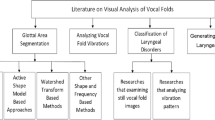Abstract
A new high-speed system for recording, processing, and analyzing vocal fold vibrations has been developed. Results obtained with this system are discussed from the technical and the medical points of view. Laryngeal movement can be recorded with a digital high-speed camera, at a maximum speed of about 5 600 frames/s and the sequence can contain as many as 8 192 single frames. Application specific software for adaptive, semiautomatic, motion analysis is used to calculate and plot the glottograms for selected points on each vocal cord. From the data obtained, we can calculate speed, acceleration rates, the fundamental frequency, amplitudes, and perturbation parameters. This approach to laryngeal examination, based on the digital films, motion plots and characteristic statistics, is a practicable method that promotes the possibilities of quantitative and graphic analysis of the moving vocal folds and overcomes the disadvantages of the currently common examination methods.
Similar content being viewed by others
References
Barnea DI, Silverman FH (1972) A class of algorithms for fast digital image registration. IEEE Trans on Comput C-21:179–186
Bloss H, Backert C, Raguse A (1993) CAMSYS, Hochgeschwindigkeitskamerasystem, IIS, Erlangen
Booth JR, Childers DG (1979) Automated analysis of ultra high-speed laryngeal films. IEEE Trans Biomed Eng 26:185–192
Bresenham JE (1965) Algorithm for computer control of a digital plotter. IBM Syst J 4:24–30
Childers DG, Paige A, Moore GP (1976) Laryngeal vibration patterns. Arch Otolaryngol 102:407–410
Eysholdt U, Tigges M, Proschel U (1994) Direct evaluation of high-speed recordings of vocal fold vibrations. The 3rd International Symposium on Phonosurgery, Kyoto, Japan, pp 16–20
Farnsworth DW (1940) High-speed motion pictures of the human vocal cords. Bell Lab Rec 18:203–208
Horn BKP, Schunck BG (1981) Determining optical flow. Artif Intell 17:185–203
Leonhardt H (1979) Taschenatlas der Anatomie, Band 2: Innere Organe. Thieme, Stuttgart, p 123
Moser M, Eysholdt U, Wittenberg T (1994) Digitale Hochgeschwindigkeitsglottographie — eine neue Methode zur Untersuchung der Stimmlippenschwingungen beim Menschen. Fortschritte der Akustik-DAGA94, Tagungsband der 20. Deutschen Jahrestagung fur Akustik, Dresden
Schultz-Coulon HJ(1980) Die Diagnostik der gestorten Stimmfunktion. Archiv für Ohren-, Nasen- und Kehlkopfheilkunde, Springer, Berlin, pp 53f
Tigges M, Eysholdt U, Pröschel U (1994) Hochgeschwindigkeitsglottographie des Einschwingvorgangs bei verschiedenen Stimmeinsatzmoden. Tagungsband, Jahrestagung der Deutschen Gesellschaft für Phoniatrie und Paedaudiologie, Bad Homburg
Wahl F (1984) Digitale Bildsignalverarbeitung, Grundlagen, Verfahren, Beispiele. Springer, Berlin
Wittenberg T, Raguse A (1993) HISPEED: Steuerprogramm fur das Hochgeschwindigkeitskamerasystem CAMSYS, Version 2.0, IIS, Erlangen
Wittenberg T, Moser M, Tigges M, Eysholdt U (1995) Analyse des Stimmeinsatzes mittes digitaler Hochgeschwindigkeitsglottographie. Fortschritte der Akustik — DAGA'95, Tagungsband der 21. Deutschen Jahrestagung für Akustik, Saarbrucken, pp 1023–1026
Author information
Authors and Affiliations
Rights and permissions
About this article
Cite this article
Wittenberg, T., Moser, M., Tigges, M. et al. Recording, processing, and analysis of digital high-speed sequences in glottography. Machine Vis. Apps. 8, 399–404 (1995). https://doi.org/10.1007/BF01213501
Issue Date:
DOI: https://doi.org/10.1007/BF01213501




